The African Union First Colored Methodist Protestant Church and Connection, usually called "the A.U.M.P. Church," is a Methodist denomination. It was chartered by Peter Spencer (1782–1843) in Wilmington, Delaware, in 1813 as the "Union Church of Africans," where it became known as the "African Union Church".

The African Methodist Episcopal Church, usually called the A.M.E. Church or AME, is a predominantly African-American Methodist denomination. It is the first independent Protestant denomination to be founded by black people. It was founded by the Rt. Rev. Richard Allen in Philadelphia, Pennsylvania, in 1816 from several black Methodist congregations in the mid-Atlantic area that wanted independence from white Methodists. It was among the first denominations in the United States to be founded on racial rather than theological distinctions and has persistently advocated for the civil and human rights of African Americans through social improvement, religious autonomy, and political engagement. Allen, a deacon in Methodist Episcopal Church, was consecrated its first bishop in 1816 by a conference of five churches from Philadelphia to Baltimore. The denomination then expanded west and south, particularly after the Civil War. By 1906, the AME had a membership of about 500,000, more than the combined total of the Colored Methodist Episcopal Church in America and the African Methodist Episcopal Zion Church, making it the largest major African-American Methodist denomination.
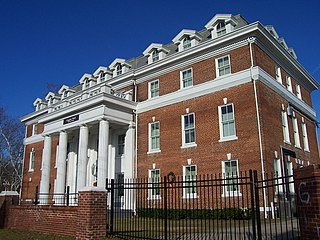
Allen University is a private historically black university in Columbia, South Carolina. It has more than 600 students and still serves a predominantly Black constituency. The campus is listed on the National Register of Historic Places as Allen University Historic District.

James O'Kelly was an American clergyman during the Second Great Awakening and an important figure in the early history of Methodism in America. He was also known for his outspoken views on abolitionism, penning the strong antislavery work, Essay on Negro Slavery. Appointed as a Methodist circuit rider in 1777, he organized preaching circuits on the frontier in central and southeastern North Carolina during the American Revolutionary War. He continued his affiliation with the Methodist Episcopal Church from its formal organization in 1784 at the Christmas Conference, when he was ordained an elder. Well regarded as a preacher, he successfully supervised pastors in several regions of Virginia and North Carolina.
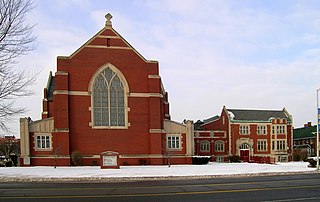
The St. John's Christian Methodist Episcopal Church is a church located in Detroit, Michigan. It was built as the North Woodward Congregational Church, listed on the National Register of Historic Places in 1982, and designated a Michigan State Historic Site in 1998.

McBee Methodist Church, also known as McBee Chapel, is an octagonal, brick, United Methodist church building on Main Street in Conestee, Greenville County, South Carolina. Built in 1856, it was designed by millwright John Adams and named for Vardry McBee (1775–1864), the "Father of Greenville," whose son donated the money to build it. The church was built with a balcony used by slaves. When the balcony was removed sometime following the Civil War, its separate door, to the left of the main entrance, was converted into another window.

Bethlehem Methodist Episcopal Church is a historic Methodist church located at Bethlehem, Taylor's Island, Dorchester County, Maryland. It was built in 1857, and is a gable-front common bond brick church across the road from a mid-19th century cemetery.

Thomas Chapel C.M.E. Church is a historic church on Moscow Avenue in Hickman, Kentucky. It is part of the Christian Methodist Episcopal denomination formed in the South after the American Civil War.

St. Peter's AME Zion Church is a historic African Methodist Episcopal church located at 615 Queen Street in New Bern, Craven County, North Carolina. It was built between 1923 and 1942, on the site of the 1914 church building which was destroyed by fire in 1922. It is a large three bay by seven bay, rectangular brick church building in the Late Gothic Revival style. It features a gabled nave flanked by two-story truncated stair towers. Also on the property is the contributing 1926 parsonage; a 2 1/2-story, frame American Craftsman style dwelling. It is known within the denomination as the "Mother Church of Zion Methodism in the South," and the oldest existing African Methodist Episcopal congregation in the South.
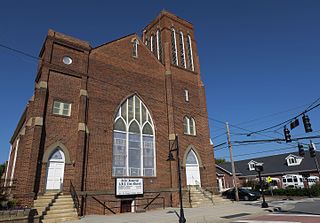
Goler Memorial African Methodist Episcopal Zion Church, also known as Old Goler, is a historic African Methodist Episcopal Zion church located at 630 Patterson Avenue in Winston-Salem, Forsyth County, North Carolina. It was built in 1918–1919, and is a rectangular brick building in the Late Gothic Revival style. It features a gable-front block flanked by two square brick towers and stained glass windows. A two-story annex was built in 1946. In 1942, the Goler Metropolitan AME Zion Church congregation split from the Goler Memorial African Methodist Episcopal Zion Church.

Lake Toxaway Methodist Church, also known as Methodist Episcopal Church South, is a historic Methodist church on Cold Mountain Road on the north side, 0.1 miles norwest of the junction with NC 281 in Lake Toxaway, Transylvania County, North Carolina. It was built in 1912, and is a small one-story, Late Gothic Revival style frame structure. It has a six-sided louvered bell tower and a tin roof.

Bethel African Methodist Episcopal Church is a historic African Methodist Episcopal church located at 369 Drayton Street in McClellanville, South Carolina. It was built around 1872, and is a one-story, rectangular frame vernacular Gothic Revival church. It has a pedimented gable-front roof that supports a square-based steeple. A cemetery is on the property. It was added to the National Register of Historic Places in 2004.

Bethel A.M.E. Church is a historic African Methodist Episcopal Church at 1528 Sumter Street in Columbia, South Carolina.

Morning Chapel Christian Methodist Episcopal Church is a historic Christian Methodist Episcopal church located at 903 E. Third Street in Fort Worth, Texas.
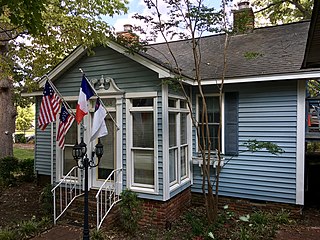
Old Shandon Historic District is a national historic district located at Columbia, South Carolina. The district encompasses 42 contributing buildings in a planned middle class residential development. They were built between the 1890s and 1950s, and the district includes examples of Queen Anne, Colonial Revival, Neoclassical Revival, and Craftsman/Bungalow style architecture. The district also includes the Shandon Baptist Church and Maple Street Southern Methodist Church.

Granby Mill Village Historic District is a national historic district located at Columbia, South Carolina. The district encompasses 97 contributing buildings associated with a cotton mill and associated mill village. The mill was initially constructed in 1896–1897, and is a large four-story, rectangular brick building in the Romanesque Revival style. It features two projecting five-story entrance towers. The Granby Mill Village includes a number of "saltbox" style dwellings reminiscent of a New England mill village. The district also includes the mill gatehouse, the two-story mill office building, commercial buildings, the Gothic Revival style Whaley Street Methodist Church, and operatives' houses.

Columbia Historic District II is a national historic district located at Columbia, South Carolina. The district encompasses 113 contributing buildings and 1 contributing site in a former residential section of Columbia. They were built between the early-19th century and the 1930s and are now mostly used for commercial purposes. The buildings are in the Greek Revival, Gothic Revival, Classical Revival, and the “Columbia Cottage” styles. Notable buildings include the Robert Mills House, Debruhl-Marshall House, Hampton-Preston House, Episcopal Church of the Good Shepherd, Crawford-Clarkson House, Maxcy Gregg House, Hale-Elmore-Seibels House, St. Paul's Lutheran Church, and Ebenezer Lutheran Church.
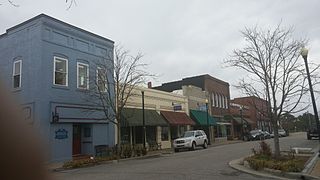
Columbia Historic District is a national historic district located at Columbia, Tyrrell County, North Carolina. It encompasses 119 contributing buildings, 1 contributing structure, and 1 contributing object in the central business district and surrounding residential sections of Columbia. The district developed between about 1880 and 1944 and includes examples of a variety of popular architecture styles. Located in the district is the separately listed Tyrrell County Courthouse. Other notable buildings include Snell's Inn, Columbia Garage, Columbia Christian Church, McClees-Coffield House, Combs-Hussey House, Frederick L. W. Cohoon House, Columbia Baptist Church (1905), W. J. White Building (1931-1932), Columbian Theatre, Wesley United Methodist Church (1912), St. Andrews Episcopal Church (1909), Tyrrell County Jail, Merchants and Farmers Bank / East Carolina Bank, Tyrrell County Bank, and Columbia Theatre.





















